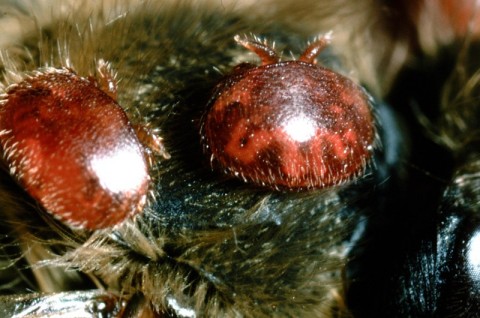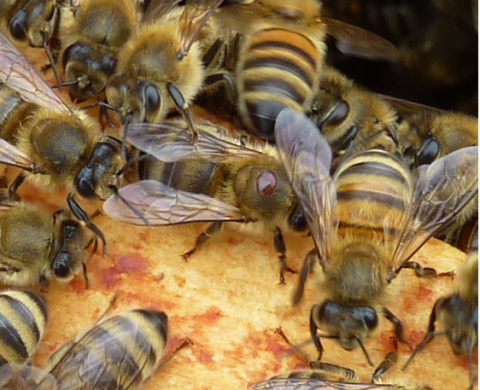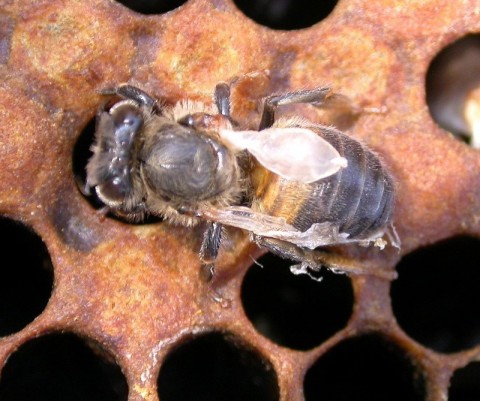 Abraham Lincoln
If given the truth, the people can be depended upon to meet any national crisis...
Abraham Lincoln
If given the truth, the people can be depended upon to meet any national crisis...
 Guildford news...
for Guildford people, brought to you by Guildford reporters - Guildford's own news service
Guildford news...
for Guildford people, brought to you by Guildford reporters - Guildford's own news service
Beekeeper’s Notes October 2015
Published on: 1 Oct, 2015
Updated on: 1 Oct, 2015
A Mite Troubling.
Hugh Coakley writes about the mite that breeds and feeds on the poor beleaguered honeybee.
Something very nasty is going on in our beehives.

Varroa mites in all their glory. They are about 1mm to 2mm across. They breed on the bee larvae and feed on the adult bee (Crown copyright).
It is hard to spot – you see the effects rather than the cause – but you know it is there. I would hazard a guess to say that there is hardly a beehive in the country which isn’t suffering to some degree or other. And beekeepers all over the country are continuing to battle against it.
It is the varroa mite, aptly named Varroa Destructor.

The red shiny oval shape on the back of the bee in the centre is a varroa mite. I photographed it latched on to the back of a bee in one of my colonies.
These tiny little creatures were introduced into the country from Asia through imports of queens and bee colonies. So we have ourselves to blame. They now breed and feed on our poor old defenceless bee. They are minuscule to us but for the bee, it is the equivalent of having a dinner plate-sized monster hooked on to you, munching and sucking at your vitals.
Varroa was not well understood in the UK in the early 1990s when it was first spotted here. There were reports of colonies failing for no obvious reason. Beekeeper numbers halved to fewer than 10,000 as they lost their colonies and lost the heart to continue.

A drone is ‘born’. Varroa mites, which bred on the larvae, are attached to the drone as it emerges from its cell (Crown copyright).
We now have ways to attack the mite. So colonies managed by a beekeeper can now control varroa numbers and survive.
But wild or feral bees, those that set themselves up in a tree hollow or cavity, are unlikely to survive for more than a year. The mite, which doubles its population every six weeks or so, doesn’t kill the bee outright. It weakens the colony so it just dwindles away.

A bee with deformed wing virus as a result of varroa. This bee won’t last long and is unlikely to be able to contribute to the survival of the colony (Crown copyright).
A sign that you have a serious infestation is when you see a bee with shrivelled up wings. This is the result of the deformed wing virus which larvae develop after being weakened by the varroa mite.
Long-standing beekeepers have said that it used to be so simple before varroa! Those of us who are newer to beekeeping know no different of course.
But I wonder what little horror we will inflict on our bees next?
On a lighter note, Guildford Beekeepers’ Association starts the next theory course for new beekeepers on January 7, running to February 25.
The courses are in the evenings at Birtley House in Bramley. Cost is £80. It is an excellent introduction to what you will need to do if you start to keep bees.
The practical beekeeping course follows on. If you are interested, email Jane Hall on janeandhughhall@aol.com.

"Found any?" - "Nope, it all looks green to me!" (See Opinion: The Future is Congested, the Future is Grey)
www.abbotshospital.org/news/">





Recent Articles
- Latest Evidence in Sara Sharif Trial
- Ash’s New Road Bridge Is Named – and November 23rd Is Opening Day
- Class A in Underwear Leads to Jail Sentence
- Historical Almshouse Charity Celebrates Guildford in Bloom Victory
- Notice: Shalford Renewable Showcase – November 16
- Firework Fiesta: Guildford Lions Club Announces Extra Attractions
- Come and Meet the Flower Fairies at Watts Gallery
- Updated: Royal Mail Public Counter in Woodbridge Meadows to Close, Says Staff Member
- Letter: New Developments Should Benefit Local People
- Open Letter to Jeremy Hunt, MP: Ash’s Healthcare Concerns


Search in Site
Media Gallery
Dragon Interview: Local Artist Leaves Her Mark At One of England’s Most Historic Buildings
January 21, 2023 / No Comment / Read MoreDragon Interview: Lib Dem Planning Chair: ‘Current Policy Doesn’t Work for Local People’
January 19, 2023 / No Comment / Read MoreA3 Tunnel in Guildford ‘Necessary’ for New Homes, Says Guildford’s MP
January 10, 2023 / No Comment / Read More‘Madness’ for London Road Scheme to Go Ahead Against ‘Huge Opposition’, Says SCC Leader
January 6, 2023 / No Comment / Read MoreCouncillor’s Son Starts Campaign for More Consultation on North Street Plan
December 30, 2022 / No Comment / Read MoreCounty Council Climbs Down Over London Road Works – Further ‘Engagement’ Period Announced
December 14, 2022 / No Comment / Read MoreDragon Interview: GBC Reaction to the Government’s Expected Decision to Relax Housing Targets
December 7, 2022 / No Comment / Read MoreHow Can Our Town Centre Businesses Recover? Watch the Shop Front Debate
May 18, 2020 / No Comment / Read More







Recent Comments